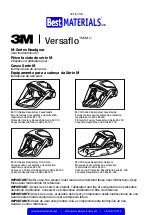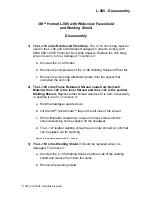
All information in this drawing is
the property of The Watt Stopper
Inc. and cannot be copied or used
without the written approval of The
Watt Stopper Inc.
Installation Instructions
CI-12
360° PIR Occupancy Sensor
SPECIFICATIONS
Voltages. . . . . . . . . . . . . . . . . . . . . . . . . . . . . . 12VDC, +2V/-0.5V
Current Consumption . . . . . . . . . . . . . . @12VDC, 28mA Maximum
Isolated Relay Rating . . . . . . . . . . . . . . . . . 1A @24VDC or 24VAC
Time Adjustment . . . . . . . . . . . . . . . . . . . 30 seconds – 30 minutes
Sensitivity Adjustment . . . . . . . . . . . . . . . . . . minimum / maximum
SENSOR ADJUSTMENT
The sensor comes factory preset and ready for operation.
If testing of operation is desired:
•
Remove the sensor’s cover (twist).
•
Refer to the
DIP switch settings
chart below for switch configurations.
•
Make sure that office furniture and fixtures are in place.
1. Confirm the Override DIP switch is set to Normal (DIP switch #4 to OFF)
2. Restore power and turn on the system interfacing with the Isolated Relay.
• There is a
one minute warm-up
when power is initially restored to the
sensor before the sensor works properly.
3. Set
Time Delay
to minimum: DIP switches #1 and 2 to ON (30 seconds).
4. Set
Sensitivity
to maximum: DIP switch #3 to ON.
5. Replace the sensor’s cover.
6. Move away from sensor and be still. The sensor should time-out after
30 seconds and the isolated relay contacts should return to their “normal”
condition (Normally Open or Closed), see Wiring Directions diagram.
Note:
If the sensor does not time-out or the isolated relay does not return to
its normal condition, move farther away or out of sight of the sensor, or see
Unwanted Sensor Activations under Troubleshooting.
7. Reset the
Time Delay
to the desired delay (DIP switches #1 and 2).
Santa Clara, CA 95050 USA
1(800)879-8585 1(972)578-1699
REV.
DESCRIPTION
REV. DATE
APPROVED
1
Release to Production
2
ECO# 032096-1
3
ECO# 073098-1
WARRANTY INFORMATION
The Watt Stopper
®
, Inc. warranties its products to be free of defects in materials
and workmanship for a period of five years. There are no obligations or liabilities
on the part of The Watt Stopper, Inc. for consequential damages arising out of or
in connection with the use or performance of this product or other indirect
damages with respect to loss of property, revenue, or profit, or cost of removal,
installation or reinstallation.
U.S. Patents:
4,757,204
4,787,722
Des360,842
Putting a Stop to Energy Waste
®
Santa Clara CA 95050 USA
☎
1(800) 879-8585 1(972)578-1699
86-0467-00r3 9/99
4-FOLD:
2-sided
MATERIAL:
Paper, white, glossy
80# Book
FLAT (cut) SIZE: 15" W x 6" H
FOLDED SIZE:
3.75"W x 6"H
INK COLOR:
Black
4-FOLD
Drawn by:
HUCKABONE
Marketing:
Marketing:
Engineering:
Doc Control:
Sheet: 1 of 2
Scale: 1 : 1
the
Watt Stopper Inc.
SANTA CLARA, CALIFORNIA
Title:
CI-12 Installation Instructions
Drawing #: Original Drwg. Date: 16 JUN 95
Rev #:
86-0467-00
Rev. Date: 2 SEP 99
3
PRINTING SPECIFICATIONS:
Check Our Web Site For FAQs: www.wattstopper.com
DIP Switch #
1 2 3 4
Normal
Override
30 seconds
10 minutes
20 minutes
30 minutes
Minimum
Maximum
Sensitivity
Sensitivity
–
–
–
–
–
–
=ON
–
=OFF
1
2
3
4
ON
LED
DIP Switch Control
for Time Delay,
Sensitivity, and
Override
1
2
3
4
ON
DIP SWITCH SETTINGS
.
=Factory Presets
.
.
.
TROUBLESHOOTING
≠
CAUTION
≠
USE PROPER SAFETY PRECAUTIONS WHEN
WORKING WITH OR NEAR HIGH VOLTAGE
LED does not flash with motion:
1. Determine if the lens is masked in the direction being tested (see Masking).
2. Check that the Sensitivity setting is set to maximum (DIP switch #3 to ON).
3. Check that the RED and BLACK wire connections from sensor are secure.
4. Check that 12VDC is between the RED and BLACK wire from the sensor.
• If it is present, the problem may be with the sensor.
Try another sensor (if available).
Isolated relay not functioning properly:
1. Check that Time Delay settings are correct (DIP switches #1 and 2).
2. Check Sensitivity setting. Also see Unwanted Sensor Activations, below.
3. Check that all wire connections from sensor are correct and secure.
4. Using proper precautions, check that there is voltage to the isolated relay.
5. Check that 12VDC is between the RED and BLACK wire from the sensor.
6. Use an ohmmeter to check the function of the isolated relay:
• Turn off the power connected to the isolated relay wires (if applicable).
- With motion in front of the sensor’s lens, check that the connection
between the GREEN and ORANGE wires is open.
- With motion in front of the sensor’s lens, check that the connection
between the YELLOW and ORANGE wires is closed.
• Turn Sensitivity and Time Delay to minimum, cover the sensor’s lens with
a cloth (not your hand), be still and allow the sensor to time-out.
- Check that the connection between the GREEN and ORANGE wires is closed.
- Check that the connection between the YELLOW and ORANGE wires is open.
Unwanted sensor activations (LED flashes):
Possible causes
1. People moving or walking outside of the desired coverage area, but in view
of the sensor and within it’s range (see Coverage Patterns and Placement).
2. HVAC vents with heavy air flow.
Possible solutions
1. Masking (see Masking).
2. Setting the Sensitivity to minimum if necessary (DIP switch #3).
3. Relocating the sensor.
Sensor Override:
If the sensor fails, set DIP switch #4 to Override position (DIP Switch # 4 to ON).
This overrides the sensor and sets the circuits to “on”.
✆
Call 1(800)879-8585 For Technical Support
✆
ORDERING INFORMATION
Catalog#
Description
CI-12
12VDC Occupancy Sensor
with Extended Range Lens (Standard)
CI-12-1
12VDC Occupancy Sensor
with High Density /Reduced Range Lens
CI-24
24VAC or 24VDC Occupancy Sensor
with Extended Range Lens (Standard)
CI-24-1
24VAC or 24VDC Occupancy Sensor
with High Density /Reduced Range Lens






















